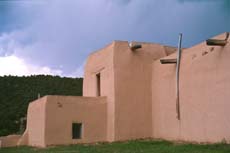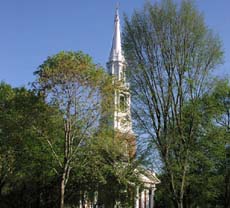Traditional anthropological "places"

Colonial church at Las Trampas, New Mexico

Church on the New Haven green, Connecticut

Map of the original settlement in Lunenburg, Nova Scotia

Houses in Lunenburg -- an idyllic small town, on UNESCO's list as a cultural treasure -- but existing on tourist money
Marc Augé prefers to reserve the term "place" for those thick and stable culturally coded areas that anthropologists love to describe. So what the modern world produces he calls "non-places." (In my terms, what he calls "non-places" would be thin places, but still places.)
He does not mean the term "non-place" in a derogatory way. In fact, he is more doubtful about the characterizations of traditional anthropological places. As I have argued elsewhere in this project, he claims that no place is as closed and no culture as insular as some anthropological descriptions suggest. The totally seamless closed culture or place is:
the indigenous fantasy of a society anchored since time immemorial in the permanence of an intact soil outside which nothing is really understandable; the ethnologist's illusion of a society so transparent to itself that it is fully expressed in the most trivial of its usages, in any one of its institutions, and in the total personality of each of its members. . . . a closed world founded once and for all long ago; one which, strictly speaking, does not have to be understood. Everything there is to know about it is already known: land, forest, notable features, religious places, medicinal plants, not forgetting the temporal dimensions of an inventory of these places whose legitimacy is postulated, and whose stability is supposed to be assured, by narratives about origins and by the ritual calendar. All the inhabitants have to do is recognize themselves in it when the occasion arises. Every unexpected event, even one that is wholly predictable and recurrent from the ritual point of view (like birth, illness or death), demands to be interpreted not, really, in order to be known, but in order to be recognized: to be made accessible to a discourse, a diagnosis, in terms that are already established, whose announcement will not be liable to shock the guardians of cultural orthodoxy and social syntax. . .
There is nothing to suggest that, yesterday or today, the image of a closed and self-sufficient world could ever -- even to those who diffuse it and therefore identify with it -- be anything other than a useful and necessary image: not a lie but a myth, roughly inscribed on the soil, fragile as the territory whose singularity it founds, subject (as frontiers are) to possible readjustment, and for this very reason doomed always to regard the most recent migration as the first foundation. Augé 1995, 44-7